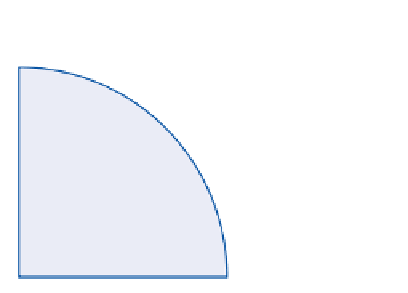Geoscience Reference
In-Depth Information
shown in
Figure 7.19
(see also
Figure 3.28B
). The
modern concept of the general circulation there-
fore views the energy of the zonal winds as being
derived from horizontal waves, not from merid-
ional circulations. In lower latitudes, however,
eddy transports are insufficient to account for the
total energy transport required for energy balance.
For this reason, the mean Hadley cell is a major
feature of current representations of the general
circulation, as shown in
Figure 7.20
. The
low-latitude circulation is recognized as being
complex. In particular, vertical heat transport in
the Hadley cell is effected by giant cumulonimbus
clouds in disturbance systems associated with the
Equatorial Trough (of low pressure), which is
located on average at 5
Rising air over South Asia (and also South
America and Indonesia) is associated with east-
west (zonal) outflow, and these systems are known
as
Walker circulations
(pp. 375-380). The pole-
ward return transport of the meridional Hadley
cells takes place in troughs that extend into low
latitudes from the mid-latitude westerlies. This
tends to occur at the western ends of the upper
tropospheric subtropical high pressure cells.
Horizontal mixing predominates in middle and
high latitudes, although it is also thought that
ARCTIC
North
Pole
TROPOPAUSE
Polar front
jet
J
N
in July (see
Figure 11.1
). The Hadley cell of the
winter hemisphere is by far the most important,
since it gives rise to low-level transequatorial flow
into the summer hemisphere. The traditional
model of global circulation with twin cells,
symmetrical around the equator, is found only in
spring/autumn.
Longitudinally, the Hadley cells are linked with
the monsoon regimes of the summer hemisphere.
°
S in January and at 10
°
60°N
Subtropical
jet
J
Polar
front
TROPICAL
30°N
TROPOPAUSE
Figure 7.20
General meridional circulation
model for the Northern Hemisphere in winter.
Source: After Palmén, 1951; from Barry (1967).
75
50
25
0
(Fluxes of enthalpy
+ potential energy)
-25
Total energy flux
Mean meridional flux
Eddy flux
-50
-75
90°N
60°
40°
20°
0°
20°
40°
60°
90°S
Figure 7.19
The poleward transport of energy, showing the importance of horizontal eddies in mid-
latitudes.



























































